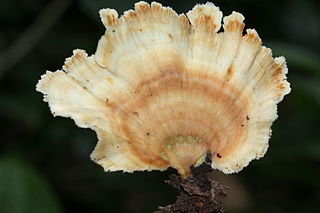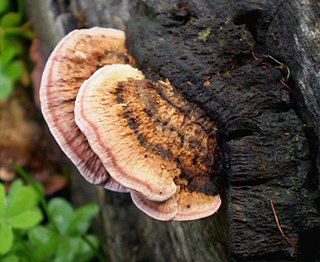
The Polyporales are an order of about 1800 species of fungi in the division Basidiomycota. The order includes some polypores as well as many corticioid fungi and a few agarics. Many species within the order are saprotrophic, most of them wood-rotters. Some genera, such as Ganoderma and Fomes, contain species that attack living tissues and then continue to degrade the wood of their dead hosts. Those of economic importance include several important pathogens of trees and a few species that cause damage by rotting structural timber. Some of the Polyporales are commercially cultivated and marketed for use as food items or in traditional Chinese medicine.

Polypores are a group of fungi that form large fruiting bodies with pores or tubes on the underside. They are a morphological group of basidiomycetes-like gilled mushrooms and hydnoid fungi, and not all polypores are closely related to each other. Polypores are also called bracket fungi or shelf fungi, and they characteristically produce woody, shelf- or bracket-shaped or occasionally circular fruiting bodies that are called conks.

The Polyporaceae are a family of poroid fungi belonging to the Basidiomycota. The flesh of their fruit bodies varies from soft to very tough. Most members of this family have their hymenium in vertical pores on the underside of the caps, but some of them have gills or gill-like structures. Many species are brackets, but others have a definite stipe – for example, Polyporus badius.

Antrodiella citrea is a bracket fungus native to Australia, and New Zealand.

Fomitopsis is a genus of more than 40 species of bracket fungi in the family Fomitopsidaceae.

Bridgeoporus is a fungal genus in the family Polyporaceae. A monotypic genus, it contains the single polypore species Bridgeoporus nobilissimus, first described to science in 1949. Commonly known both as the noble polypore and the fuzzy Sandozi, this fungus produces large fruit bodies that have been found to weigh up to 130 kilograms (290 lb). The upper surface of the fruit body has a fuzzy or fibrous texture that often supports the growth of algae, bryophytes, or vascular plants.

Flabellophora is a genus of poroid fungi in the family Steccherinaceae. The genus was circumscribed by New Zealand-based mycologist Gordon Herriot Cunningham 1965. Most species in the genus were described by E. J. H. Corner in 1987.

Nigrofomes is a genus of fungi in the family Polyporaceae. It was circumscribed by mycologist William Alphonso Murrill in 1904 with N. melanoporus as the type species. This fungus, first described as Polyporus melanoporus from collections made in Cuba, is common in tropical America. N. nigrivineus, found in Papua New Guinea, was added to the genus in 2013 and N. sinomelanoporus from China was added in 2018.

Skeletocutis is a genus of about 40 species of poroid fungi in the family Polyporaceae. The genus has a cosmopolitan distribution, although most species are found in the Northern Hemisphere. It causes a white rot in a diverse array of woody substrates, and the fruit bodies grow as a crust on the surface of the decaying wood. Sometimes the edges of the crust are turned outward to form rudimentary bracket-like caps.

Tyromyces is a genus of poroid fungi in the family Polyporaceae. It was circumscribed by mycologist Petter Karsten in 1881. The type species is the widely distributed Tyromyces chioneus, commonly known as the white cheese polypore. The phylogenetic position of Tyromyces within the Polyporales is uncertain, but it appears that it does not belong to the "core polyporoid clade". Tyromyces is polyphyletic as it is currently circumscribed, and has been described as "a dumping place for monomitic white-rot species with thin-walled spores."

Inonotus nothofagi is a species of fungus in the family Hymenochaetaceae. It is parasitic, and causes a white rot in the wood it infects. First described scientifically by mycologist George Herriot Cunningham, it is found in Australia and New Zealand where it infects Nothofagus cunninghamii, and India, where it grows on oak.

Rhodofomitopsis lilacinogilva is a species of bracket fungus in the family Fomitopsidaceae. Known primarily from Australia, it has also been recorded from Brazil and India. It is a white-rot fungus that grows on rotting eucalyptus wood. Its main identifying feature is the lilac colour of the pore surface on the underside of the fruit body.

Rigidoporus laetus is a species of polypore fungus in the family Meripilaceae. It was originally described in 1883 as Polyporus laetus by Mordecai Cubitt Cooke. Peter Buchanan and Leif Ryvarden transferred it to Rigidoporus in 1988. Found in south Australia, the fungus is a plant pathogen that causes white rot in Eucalyptus.

Nigroporus vinosus is a species of poroid fungus in the family Steccherinaceae, and the type species of the genus Nigroporus. Its fruit bodies have brownish caps with tinges of purple or red. The cap underside has a pore surface the same colour as the cap, and minute pores. Nigroporus vinosus has a pantropical distribution. It has been recorded from Africa, North America, Central America, South America, Asia, and Oceania. It is a wood-decay fungus that causes a white rot.

Metuloidea is a genus of five species of fungi in the family Steccherinaceae. The genus was circumscribed by New Zealand-based mycologist Gordon Herriot Cunningham in 1965. The type species is M. tawa, a fungus originally described by Cunningham as a species of Trametes. Formerly classified in family Meruliaceae, Metuloidea was moved to the Steccherinaceae in 2016, following prior research that outlined a revised framework for the Steccherinaceae based on molecular phylogenetics.

Tyromyces pulcherrimus, commonly known as the strawberry bracket, is a species of poroid fungus in the family Polyporaceae. It is readily recognisable by its reddish fruit bodies with pores on the cap underside. The fungus is found natively in Australia and New Zealand, where it causes a white rot in living and dead logs of southern beech and eucalyptus. In southern Brazil, it is an introduced species that is associated with imported eucalypts.
Yuchengia is a fungal genus in the family Polyporaceae. It is a monotypic genus, containing the single species Yuchengia narymica, a crust fungus formerly placed in the genus Perenniporia and originally described as Trametes narymica by Czech mycologist Albert Pilát.
Skeletocutis stramentica is a species of poroid fungus in the family Polyporaceae that is found in New Zealand.
Tyromyces toatoa is a species of poroid fungus found in New Zealand. It was described as a new species by G. H. Cunningham in 1965. The type collections were made by Joan Dingley, who found the fungus in Taupō, Mount Ruapehu, near Whakapapa Stream. She found it fruiting on the bark of dead branches and trunks of Phyllocladus alpinus, at an elevation of 1,000 metres (3,300 ft). The specific epithet toatoa evokes the Māori name of the host plant.
Anjali Roy was an eminent Indian mycologist and academician. The fungus genus Royoporus is named in her honour.
















